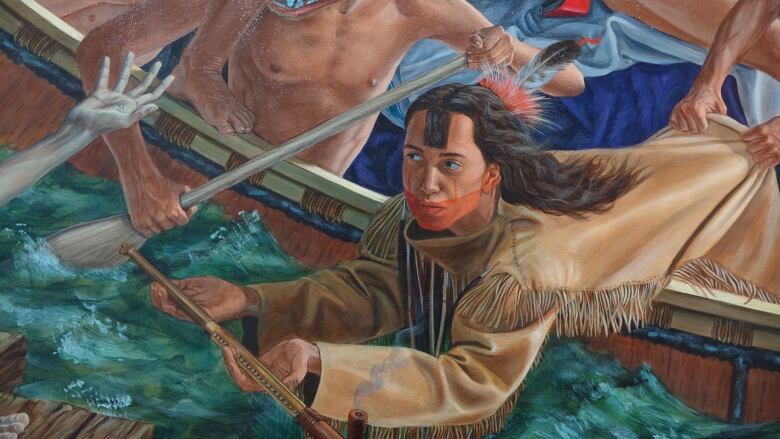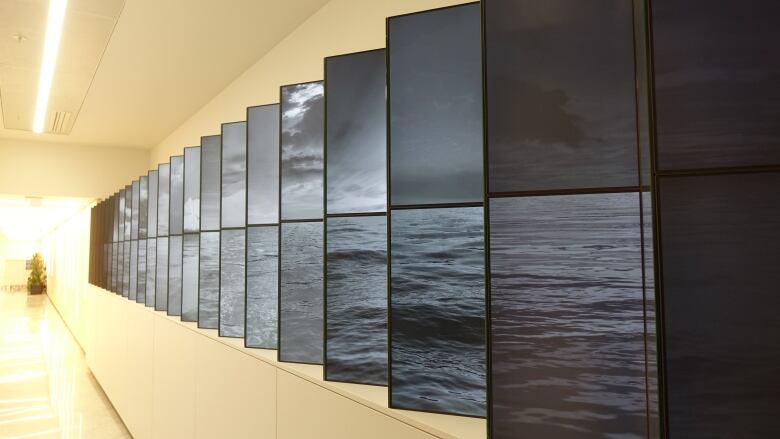New Canadian Embassy woos the French with Indigenous art
Paintings by Indigenous artist Kent Monkman featured in inaugural show

Whether visiting for a trade negotiation, to replace a lost passport or applying for a visa at the new Canadian Embassy in Paris, the backdrop is art that reflects Canadian values.
A few blocks away from its former home, the new embassy is located in a smaller but completely renovated building with updated, high-tech facilities designed to show off Canada's artistic talent.

The walls, lobby, meeting spaces and consular offices at the new embassy are covered in art — and most of it is by Indigenous artists.
And for the first time, the embassy, the Canadian Cultural Centre and its gallery are under the same roof.

Culture is important to the French and Paris is arguably the epicentre of the art world, according to Manon Dumas, the centre's director.
With that in mind, Canada's new embassy in the City of Light is a tribute to Canadian artists' creativity.
"Cultural diplomacy is one more tool to make sure that Canada's interests and Canada's values are resonating around the world," said Dumas, noting the country's values of inclusion, diversity and reconciliation.

Works by Indigenous artist Kent Monkman, an internationally acclaimed Cree artist, were chosen to inaugurate the new centre. His massive new paintings depict his heroic alter ego, Miss Chief Eagle Testickle, in a series of mythical and historical scenarios.
"Here we have two major themes that are screaming out at us: LGBTQ rights and reconciliation with Indigenous peoples," said Manon. She said the featured art also inspires related lectures and panel discussions at the embassy.
In the new works, Monkman created provocative responses to the traditional European paintings that he viewed at the Musée des Confluences in Lyon.

The centrepiece of the exhibition is Miss Chief's Wet Dream, a monumental eight-metre-wide canvas. It's inspired by two iconic historical French paintings: Théodore Géricault's Raft of the Medusa and Eugène Delacroix's Liberty Leading the People.
Monkman's version is populated with Indigenous heroes and symbols and notable representatives of the old order of Europe.

"We wanted a show that was totally new. And we wanted it to be about the relationship between France and Canada," said curator Catherine Bédard.
She described Monkman's work as "reverse colonization of European painting."
Art woven throughout
The art doesn't stop at the gallery's door. It is woven throughout the space, reinforcing a vision of Canada the embassy wants to the world to see.

For instance, the window of the embassy's conference room — with its view of the Eiffel Tower — is imprinted with Indigenous symbols. Marianne Nicolson, a Dzawada'enuxw visual artist from B.C., engraved 195 images from nature onto the wall of glass. Each one represents a signatory of the 2015 Paris Climate Accord.

Constructed from traditional clay tobacco smoking pipes, Nadia Myre's illuminated Tree of Shifting Forms stands tall in the embassy's courtyard.
Myre, a Sobey Award-winning contemporary artist, is an Algonquin member of the Kitigan Zibi Anishinabeg First Nation.

A video installation of undulating ocean waves and a constant horizon accompanies visitors on their journey toward the consular office, and perhaps, a new life.
The installation — created by Tamira Sawatzky, Elle Flanders and Eshrat Erfanian — promises hope at the end of the long corridor and reflects the voyage (literally or figuratively) that many have made to get there.

Meanwhile, a huge mosaic dominates the embassy's front lobby, bringing visitors face to face with Toronto basketball fans.
Toronto artist Stephen Andrews collaborated with artisans from Montreal's Mosaika, an art and design company, to piece together photographs of a huge multicultural crowd typically filling the stands at a Raptors game.
"We want to be influential, to stimulate debates, questions and interrogations and emotions," Bédard said.
Watch the creation of the piece made by Andrews and Mosaika: